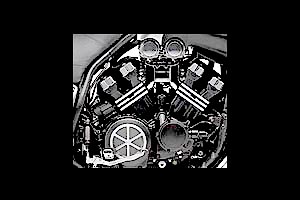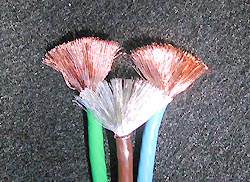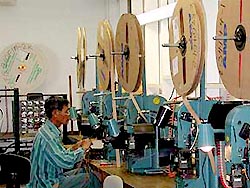|
 |
|
 |
|
|
|
|
| How long since you transitioned into audio manufacturing full-time? |
|
 |
|
About four and a half years. I'm still somewhat in shock how we managed to grow this fast. After all, until recently, we were a power-cable-only company. Our type of product still owns little mind share within a small market niche of music lovers. Although, this has been changing recently with the use and acceptance of our products in many of the finest recording studios around the world.
|
|
 |
|
|
|
| I didn't realize it hadn't been longer. Boy, you surely have come a long way in a hurry, Caelin. Let's talk about common misconceptions as they pertain to your field. |
|
|
Power line products are generally subtractive, not additive. This is a biggie. Since most A/V systems require more than the two outlets provided by a household duplex, some type of power distribution is required to supply power to all of the components. Excluding audiophile products for a moment, the vast majority of A/V systems use a common power-strip or, worse yet, a surge-strip intended for computer use. Virtually all power strips and power conditioners will degrade the audible and visual performance compared to a power connection directly into the wall duplex.
This is caused by the cheap contacts, wiring and inferior filter components used in these types of devices. They are designed to address a market where a low price is paramount and audio or video performance is never a consideration. Unfortunately, many "audiophile" power products share the same failings as those found in these common power strips.
|
|
 |
|
|
|
Many people believe in inductively filtering power with coils or ferrites. Inductors act as low-pass filters and work brilliantly at preventing HF noise from entering the system. As long as you believe in the power company as the Evil Empire, that approach will look appealing indeed. The fact remains that your components are the primary culprit. You see, in-line filters also prevent high-frequency noise from moving away from the component that generates it. Putting an inductor in series with your AC simply acts as a reflector. All the dreaded haze, blur and grain you wanted to get rid of remains in the system. In fact, it's now shared between the components in ping-pong fashion and hence multiplied.
|
|
|
|
 |
|
Another fallacy is the belief that power is a low frequency phenomenon: 50 or 60 cycles. If that's what you believe, installing a low-pass filter is a good idea. It's an excellent approach as long as you power light bulbs or fans. Those appliances pull current across the full AC-power sine wave. However, electronic components pull power in high-frequency pulses, at the crest of the AC wave form. When the AC wave reaches a level in excess of the stored voltage in the power supply capacitors, the rectifier switches on. This drops the impedance of the power transformer windings to virtually zero causing an instantaneous and hard current pull that has very high frequency harmonics. The low-pass coil naturally resists the HF current change, limiting the amount of instantaneous current that can be delivered to the storage capacitors during that cycle. As the AC wave drops, the rectifier reverses and shuts off so you can't pull current until the wave form comes around again. So you wait for these 50-60 cycle time intervals to recharge the caps.
|
|
 |
|
The filter coil acting as a rev limiter of sorts.
|
|
 |
|
|
|
|
 |
|
Indeed, that's quite a useful analogy. I also have a high-performance automotive background. Power behaves similarly to airflow intake and exhaust systems. This analogy would make our coil a sort of restrictive muffler. When you look at AC current flow in terms of fluid dynamics -- electron plasma flowing through metal conductors at high speed, inquiring into what will cause an impediment to that flow, what will cause resonances and reflections -- you can approach the whole subject from a new system's point of view.
|
|
|
I have a warehouse full of power cord designs. You name it, I've made it: Ribbons, complex braids, various geometries; silver, gold, platinum, alloys; 4 gauge, 0 gauge, 0000 gauge; dielectrics; connectors ... I'm literally running out of room now. Over time, I've come to learn that, while each component reacts differently to power delivery, there are essentially only two main classes of devices. There are those that require high current draw and are sonically relatively pure; and those that generate large amounts of noise such as processors, DACs, transports and some solid-state components.
|
|
These two categories require two very different basic power cord designs. The first relies on larger conductors and very low inductance (quite unlike the added inductance that results from the low-pass filter effect of series coils, capacitors or Ferrites). An example of this type of design is our Taipan [right]. Best results with this design are on amplifiers, subwoofers, video projectors and other high-current components.
|
|
|
|
 |
|
 |
|
|
|
Components in the second category require noise filtration and are far less critical with regards to current demand. This includes all digital source components and some solid-state amplifiers and preamplifiers. Our top performer in this class is the Anaconda-Vx [left]. Its Anaconda Alpha mate is the equivalently extreme offering in what we call the PaceSetter class, positioned just above the Taipan.
|
|
 |
|
| How about conductor purity? |
|
Cable doesn't have many visual constituents. The actual conductors, for the most part, remain invisible. The common "copper is copper" consumer reluctance is understandable. It's like looking at tires. They're all round, they're all black, they all have some kind of tread pattern. A tire's a tire's a tire - a mobile Gertrude Stein. But even an inexperienced Sedan driver will instantly tell the difference between a passenger and optimized racing tire. The racing tire is still made from rubber - but clearly not all rubber is the same.
|
|
 |
|
|
When you're talking about cable and its constituents -- the raw conductor, the dielectric, the termination, the geometry of the conductors -- everything matters. The materials science side of things is far from simple. In the early days of High-end cables, clever marketers fulfilled the need for brand differentiation by placing emphasis on certain intangibles - conductor purity, for example. In truth, there are limited sources for copper and silver ingots, plants that would draw or cast these raw blocks into actual wire.
|
|
|
|
 |
|
The wire used in all of our products, even the least expensive, is designed and produced to our specifications. You won't find Mil-Spec or cable warehouse wire used in our products. People who claim six or eight nines purity? Let's just say that you cannot obtain certification papers for this type of purity. Anywhere. It doesn't exist - except in our audiophile world. Copper is specified by CDA numbers which are the technical grades of the raw metal. The top-quality copper with certification papers is CDA-101. It has a specification of 99.997% purity. There are lesser grades such as CDA-102, 103 or 112- but you won't get certification papers. There's ETP copper which is a standard grade. There's mil-spec copper commonly used in hookup wire. CDA-101 wire can't be bought off the shelf. You have to make it yourself from the raw copper ingots.
So, asI said previously - we do exhaustive testing of all materials including wire purity. Wire purity does make a difference - to a point. Where the copper is mined is often more important than the absolute purity, just as purveyors of semi- or precious stones will have preferences for certain mines due to the types of impurities or inclusions that occur in various geographical locations. Naturally, we guard some of the more important findings and conclusions as our intellectual property. What I can say? Take drinking water. You obviously don't want lead or other toxic heavy metals. But how about calcium, iron or certain trace elements? Impurities aren't all the same by a long shot. Some in fact may be desirable. Think of steel metallurgy where the deliberate inclusion of minute amounts of foreign substances radically alters the materials properties of the raw metal.
Purity is very important as it relates to corrosion. Since electrons travel primarily on the surface of the conductor, copper oxide molecules become a significant impediment to current flow. That makes outrageous claims of 1ppm purity (1 part-per-million) inside the conductor utterly irrelevant.
|
|
|
 |
|
| Is that why folks go through pains polishing their raw conductors and applying anti-corrosion treatments? |
|
 |
|
|
Certainly. In the Hydra, we polish the copper buss bars. We bake them. We cool them. We perform several proprietary treatments to enhance the performance properties of the raw material. We've had a cryogenic lab for more than three years. What we do goes far beyond liquid nitrogen immersion alone. However, now that the cryo cat is out of the bag purring happily in all the chat rooms, we no longer see a reason to protect that particular aspect of our own work. We simply don't talk about the other treatments. Why dilute our engineering advantage? There are those people who maintain that there's no such thing as the "black arts" or esoteric knowledge in audio.
|
|
 |
|
|
Let's just say that those with the knowledge aren't giving it up and those who don't have it would have you believe that it doesn't exist. Well, I guess that it doesn't for them. We've spent a lot of time and significant funds to conduct the experiments and research that would result in true technological advances that demonstrably outperform older solutions. People of course always look for that one single item, the magic bullet that mysteriously solves all ills and conquers all engineering challenges. Wire purity. Geometry. Connectors. Dielectric. What exactly is it that makes this cable special?
|
|
 |
|
It's the balance of all things, grasshopper. The Great Tao. Now, what side of the door did you leave your shoes on when you entered?
|
|
 |
Exactly. If you can extract just 2% of improvement in any one area, then do the same for all the others variables? Pretty soon you arrive at a performance increase that's audibly significant. And that's how all our products are devised. Every single variable is optimized, considered in the context of the total product. Our products perform better not for one single reason. The reasons are many. If you study what's on our website, you'll agree that we go far beyond the call of duty to tell people what's in our products and how they're made. Then add the things we can't talk about. We don't ask you to believe that our products are better based upon these or other technical justifications. We want you to put them to the test in your own system and verify the differences for yourself.
|
|
 |
|
| About that popular single, zero, long-grain crystal debate? |
|
 |
I've experimented with cast versus drawn wire, with single- and zero crystal variants. There were differences which could be discerned in listening tests although I personally consider them to be slight in magnitude. They do, however, represent a valid product differentiation.
The dielectric is important since it's the material that comes into contact with the wire surface where the electrons flow. It's quite simple to measure dielectric energy storage and time delays of subsequent re-radiation into the conductor. Interestingly enough, the insulation that measures superior doesn't, in actual listening, always turn out to be the best-sounding. That's similar to the old zero-distortion transistor versus high-distortion tube debate - while one measures better, the other may sound better. The conscientious cable researcher must remember that the final arbiter of his work is the human ear. In certain areas, it's still more sophisticated and sensitive than we can as yet correlate with measurements.
|
|
 |
|
| That's where the art enters the science? |
|
|
|
|
|
 |
|
| The analogy I like is that of a master chef making a soup. You need good stock to begin with - high-quality ingredients, superior materials. Then the question becomes: What do you want this soup to taste like? You need to have some concept, some goal in mind. Then you take your base stock -- your wire in this case -- that immediately imparts a certain sound, a certain flavor. Copper has a specific sound. So does silver. Both have a certain characteristic signature that's intrinsic to the material. |
|
|
 |
|
|
Now your dielectric becomes a spice that augments this base flavor. Copper has a weighty, meaty sound that's a little soft in the highs, perhaps a little blurry or fuzzy - certain coppers can even be a little grainy. If you know what all the different dielectrics sounds like, you now carefully select one appropriate for how you desire to balance these basic copper qualities. How do you want to complement their strengths? How to compensate for their weaknesses? Then you think about the different types of connectors, the metals you want to use...
|
|
|
|
 |
 |
|
|
 |
|
|
|
|
|
|
|
|
|
|
|
|
|
|
|
|
|
|
|
|
|
|
|
|